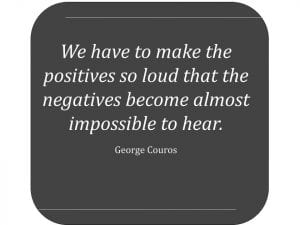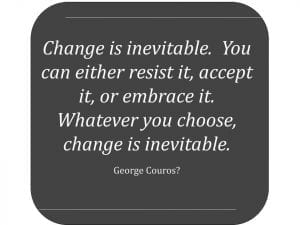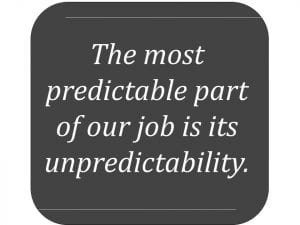One of the many things I enjoy about my job as an instructional literacy coach is that I get to work with so many different people. I get to work with students (the best!), administration, parents, community members, and teachers. Our teacher teams at all grade levels are a mix of personalities, as is to be expected. Despite the differences among them, all of us in this business have the very same thing in common: we want what is best for kids.
A Culture of Change
As we launch the 21-22 school year at FMCSD, we are experiencing major changes, as I wrote about last week. I’m noticing some trends that are surfacing as people respond to our changes… and to the normal beginning-of-the-school year “chaos” that inevitably ensues. People are telling one of two stories: 1) The culture on this team/in this building/in this district is terrible OR 2) The culture on this team/in this building/in this district is awesome! Both mindsets are completely understandable, and I’ve found myself in both camps in different moments, or even for entire days. The question I keep coming back to is: What story am I telling to myself and others, and how is that story contributing to our overall culture? And as with most things I write about, I’m specifically referring to education, but this question certainly applies to any other profession, and any other aspect of life.
When something comes our way that we don’t like, or that we are not used to, (or when we are teaching in classrooms that have reached over 100 degrees, or when our schedules change nearly every day!), it’s perfectly understandable to become frustrated and resist change. What we do after that initial resistance, though, makes all the difference in the world. Reminders that I have to continually revisit include: 1) There is probably much more to this situation/decision than I am aware of 2) How is this situation going to benefit students (remembering that we are all in this for that very reason) 3) Who are “my people,” (as the one and only Dr. Jody Carrington lovingly calls them): those people that I can trust with my story, know that they recognize my need to vent and don’t, in turn, feel the need to share the story and perpetuate the negativity 4) What can I do to improve the situation (I may not be able to control the situation, but I can control how I respond to it) 5) What are the lessons I’m going to walk away with, and 6) (repeat of the question from before) What story am I telling to myself and others, and how is that story contributing to our overall culture?
Our answers to these questions are a reflection of our mindset. Every person’s mindset contributes to the overall culture of a team/building/district. We all have mutual accountability to building that culture. How can we manage multiple challenges, while maintaining a positive growth mindset? If our focus remains centered on growth for all, we recognize progress comes through struggle. When we look for opportunities to celebrate growth as opposed to focusing on the struggle that led to that growth, we are maintaining that positive growth mindset, and we are shaping the positive culture that we desire. This is right in line with what George Couros tells us:

We may not recognize it in the midst of discomfort, but discomfort is feeding our personal and professional growth. In Episode 2, Season 4 of the Amplify’s Science of Reading: the Podcast, Dr. Tracy Weeden reminds us, “If you’re not uncomfortable, you’re probably not doing the right work.” I couldn’t agree more… that is when I’m in my current “calm” state of mind – much harder to agree with when I’m in the middle of discomfort! 🙂 But what if we could revisit this reminder throughout our days, where we are likely to experience discomfort? Perhaps we can anticipate the discomfort and embrace the learning and growing that will come with it. Is it too crazy to think we should probably even seek discomfort, especially when we haven’t experienced it in some time??? What if every school year, every month, every day, change and discomfort are thrown our way? This question throws me back to last week’s quotes, which bear repeating:


Some Wisdom shared by George Couros
Partway through writing today’s post, I took a break and read some email. The timing couldn’t have been more perfect, as I came across a weekly email from George Couros, where so much of what he wrote about is resonating with my topic today. George, as always, you are the source of soooooooo much inspiration!!! This part of his email is perfectly fitting:
“I was led to this article this week titled, “50 Very Short Rules for a Good Life from the Stoics” by Ryan Holiday, and I loved it! The description states that it shares ‘The best pieces of wisdom gathered from a body of work that spans 2,000 years’ and many of the short lessons truly resonate! Here are a few of my favorites from the article:
6. You are the product of your habits.
7. Remember you have the power to have no opinion.
18. Be strict with yourself and tolerant with others.
48. The obstacle is the way.” (Sound familiar, Clint?)
After reading George’s email, my mind keeps circling back to my original question: What story am I telling to myself and others, and how is that story contributing to our overall culture? No matter the change/the situation, I have the power to tell the story, and that story starts with the one I am telling myself. I have a choice to make, and it’s vitally important that I choose carefully if I desire to work in an environment with a positive culture. We all play a part in building that positive culture.
The Culture of Aging
As educators, we are fortunate to accumulate many stories from our students – some heartwarming, some heartbreaking, and some that make us laugh. The latter is the story that follows:
Earlier this week, as I supervised students on the playground before school, a tiny kindergarten boy approached me and unabashedly said, (as kindergartners do): “Do you know that when people get old they die? And we have a grandma that works in our classroom and she is going to die pretty soon. My parents are getting older and they’re probably going to die.” To which I responded, “Yes, buddy, we’re all going to die, but you will be a very old man before your parents die. You don’t have to worry.” With a stricken look on his face, and after some pondering he replied: “Well then I’m going to be an old man and die.” My response: “But the cool thing is that we don’t have to worry about that for a very long time. We get to focus on living and having fun. You get to play on this playground and have a great time!” He looked at me skeptically, ran off to play, and promptly returned. He looked right at me, circled his finger in my face and with 100% certainty and seriousness, said, “You’re getting close.” I didn’t want to, but had to be sure, so I asked, “Close to what?” As he skipped away, he looked over his shoulder and replied, “Dying.”
How’s that for building positive culture???

I am going to focus on remembering I have the power to NOT have an opinon.
Kindergartners and their wisdom!